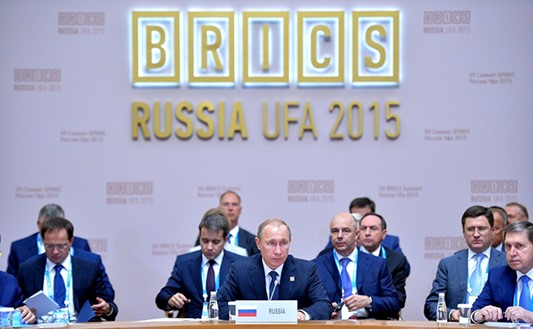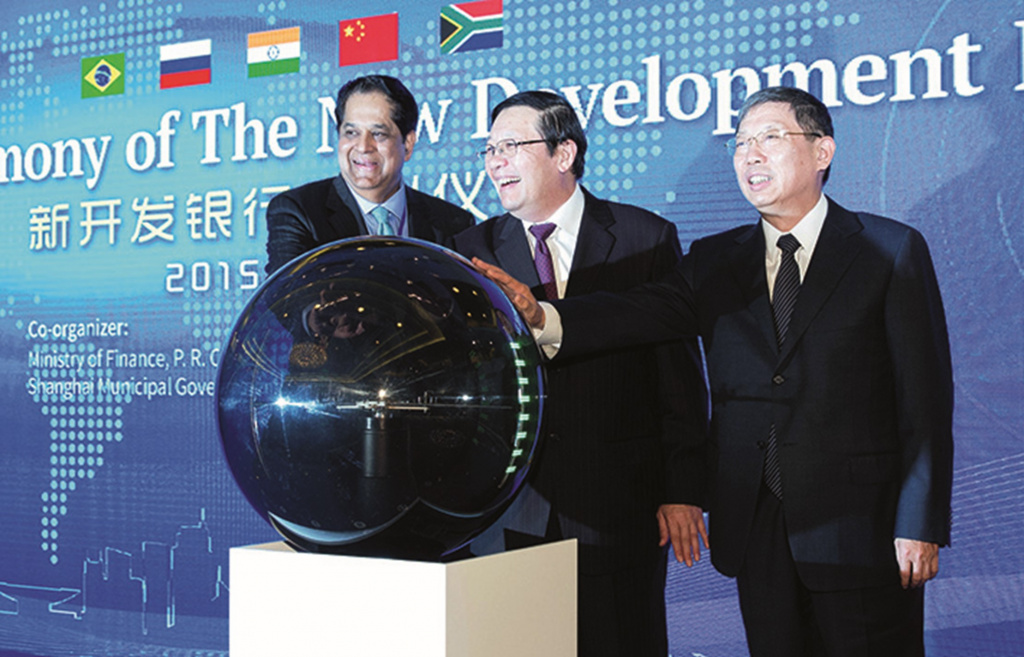A Promising Model of Cooperation. Why BRICS Plus, as a new model of international cooperation, is suitable for a multipolar era
In
Log in if you are already registered
The 15th BRICS (Brazil, Russia, India, China and South Africa) Summit in South Africa promised to be the event of the year from the day it was announced. Global media was awash with analysis of the popularity of the BRICS Plus format. Dozens of countries applied to participate in the summit. Even French President Emmanuel Macron asked for an invitation on behalf France, a NATO and EU member. BRICS Plus is popular because it is a new format of international cooperation that respects member sovereignty and focuses purely on economics. BRICS Plus is warmly received thanks to the history of the BRICS group, its institutional design, and the momentum the group is gaining globally.

Russian President Vladimir Putin attends the Seventh BRICS Summit in Ufa, Russia, on 9 July 2015 (PRESIDENT OF RUSSIA WEBSITE)
The BRICS model was not drafted by a handful of powerful politicians, but rather emerged as a product of nations coalescing around shared ideas of economic development. The term itself was coined by a Goldman Sachs economist Jim O’Neill in 2001. He used the term to describe what at the time were the most promising emerging markets in the world. BRICS was used as an analytical framework and there was no notion of the economic coordination mechanism that we see today.
Community not bloc
But the idea was picked up by the constituent countries. The First BRIC Summit meeting (South Africa was not a member at that time) was held in Russia in 2009. Coordination deepened continuously and in 2023 there were even conversations about a BRICS currency.
The way BRICS emerged without “centralising pressure” informs its structure today. There are no imposing treaties, nor a secretariat with its own political interest; instead, there is ongoing multilateral coordination. Perhaps the most centralising institution of the BRICS grouping is the New Development Bank (NDB), which was inaugurated by BRICS leaders at the Sixth BRICS Summit in Brazil in 2014. As Zhu Jiejin, professor at the School of International Relations and Public Affairs of Fudan University, has said, “In terms of governance structure, the NDB differs from the World Bank, as its founding members have equal voting rights and no country has a veto.” This institutional design mirrors the ethos of BRICS and is attractive to smaller developing countries often struggling to find a voice in international forums.
The steady development of the BRICS mechanism, aligned firmly with the Charter of the United Nations, meant the BRICS has developed into a community rather than a bloc in the traditional sense. As a result, countries’ internal affairs remain off-bounds, no political demands are placed on members, and there is no single hegemon with outsized influence on the direction of the grouping.
The history of the BRICS model informed its current decentralised design. And the unique institutional framework is what so many countries across Africa and the rest of the Global South find so attractive.

Lou Jiwei (centre), then minister of finance of China, Yang Xiong (right), then mayor of Shanghai, and K. V. Kamath, then president of the New Development Bank, witness the launch of the bank in Shanghai on 21 July 2015 (ZHANG CHUNHAI)
Opening the doors
China championed the expansion of BRICS to BRICS Plus by inviting 13 developing economies to join the 2022 BRICS Summit. African countries had already been boosting relations with BRICS, with leaders of 18 African countries and several African regional organisations invited to the 2018 summit in Johannesburg, South Africa, and the adoption of the “Plus” suffix opened the doors fully.
Assuming the chairmanship in 2023, South African President Cyril Ramaphosa said he will “use this opportunity to advance the interests of our continent.” Russia’s Foreign Minister Sergey Lavrov echoed this sentiment, stating “Russia welcomes this development.” Unsurprisingly, several African governments applied to join, including Algeria, Egypt, Nigeria, Sudan and Zimbabwe.
Besides the attraction of the BRICS Plus community, nations are also being pushed towards it. The push is intensifying as the established international coordination mechanism struggles with the changing balance of power. At a time when the BRICS Plus model offers investment, European ambassadors continue colonial attitudes to the point that they have to be expelled, as the recent case of Germany’s top diplomat in Chad shows. Similarly with culture, as Uganda pursues its sovereign right to protect family values, US politicians threaten the country with sanctions and cutting aid.
More broadly, observers note that the use of unilateral sanctions, militarisation of trade, and the push of a liberal-progressive global culture by the US and its allies are pushing non-aligned states to tighten relations with the BRICS. As Oleg Yanovsky, a leading Russian foreign affairs scholar, points out, the West offers an “us-and-them bifurcation” while China and Russia’s international initiatives including BRICS provide the opportunity to remain non-aligned. This factor drives developing countries to join the BRICS.
In addition, the momentum of the BRICS acts as a draw towards the grouping. Heads of state see where their partners and neighbours are going and the decentralised development benefits they are receiving, and naturally want to be part of the community. Even before the expansion, BRICS accounts for a quarter of global GDP and 41 percent of the world population. The economic success story of each member, including Russia, whose economy is growing despite unprecedented Western sanctions, motivates countries in the Global South to be part of the growth story. A successful, rapidly growing, and decentralised community is one that developing nations should want to join - so it is no surprise that they are applying to participate.
The world is at the precipice of a paradigm shift in international relations. Soon, there will be no great power duality or unipolar hegemony, but a broad array of rapidly developing states across the world. Each time-period needs its international coordination model.
Around a century ago, the League of Nations was established in Europe to usher in a new paradigm of diplomacy. It failed, but lessons were learnt and the United Nations was created after World War II.
As the world becomes multipolar, the BRICS Plus community is growing. The explicit rejection of domestic and cultural policy dictate, the rejection of letting national security matters affect trade, the rejection of militarising the grouping or positioning it against other organisations all draw countries in.
And what underlines the extent to which the BRICS Plus model heralds a new paradigm is that its origin is not rooted in conflict but cooperation. The BRICS Plus model is fitting for the coming paradigm shift away from unipolar politics to a world of many development hubs and diverse civilisations.




